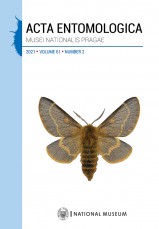The Phanaeus tridens species group (Coleoptera: Scarabaeoidea): a dung beetle group with genital morphological stasis but a changing ecological niche
Moctezuma Victor, Halffter Gonzalo, Lizardo Viridiana
Acta Entomologica Musei Nationalis Pragae 61(2): 447-482, 2021
Published online: 18th December 2021
Views: 2003
Abstract: The Phanaeus tridens species group is revised and found to consist of twelve
species: P. tridens Castelnau, 1840, P. moroni Arnaud, 2001 stat. rev., P.
balthasari Arnaud, 2001 stat. rev., P. daphnis Harold, 1863, P. coeruleus
Bates, 1887 stat. rev., P. herbeus Bates, 1887 stat. rev., P. substriolatus
Balthasar, 1939 stat. rev., P. furiosus Bates, 1887, P. pseudofurcosus
Balthasar, 1939 stat. rev., P. nimrod Harold, 1863, P. victoriae Moctezuma sp.
nov., and P. eximius Bates, 1887. The majority of the name-bearing types of the
group were revised. The neotype for P. tridens is suggested herein. The
following junior subjective synonymies are recognized: P. frankenbergeri
Balthasar, 1939 = P. tridens Castelnau, 1840, P. tricornis Olsoufieff, 1924 = P.
herbeus Bates, 1887, and P. babori Balthasar, 1939 = P. nimrod Harold, 1863;
while P. furcosus Felsche, 1901 = P. furiosus Bates, 1887 is recognized as a
junior objective synonymy. The species within the P. tridens species group are
diagnosed by the morphology of the pronotum and elytra, while the genital
morphology of males is found to be homogeneous and uninformative for species
delimitation. Most species within the group show a wide diversity of colouration
(showing green, red, and blue chromatic phases). This probably led to
taxonomical confusion by previous authors. Here, we present a new identification
key, species distribution models. Habitus photographs and character
illustrations for all the species within the group are provided. The climatic
niches overlap widely in P. herbeus and P. daphnis, but the other species within
the group show a reduced overlap in their climatic niches. Consequently, the P.
tridens species group is proposed as a case of morphological stasis that might
be explained by a trade-off between the evolution of pronotal structures and
genitalia, while differences in the ecological niche might promote speciation.
Key words: Coleoptera, Scarabaeidae, Phanaeini, scarab rainbow dung beetles, iridescence, chromatic variation, ecological niche, distribution model, Mexico, Neotropical Region
Papers
Tipula (Vestiplex) from Yunnan and Tibet, China: one new species and redescriptions of five known species (Diptera: Tipulidae)Yagder serratus, a new eyeless weevil from Mexico and the non-monophyly of Brachycerinae, the evolutionary twilight zone of true weevils (Coleoptera: Curculionidae)The tribe Anthocorini in Japan (Hemiptera: Anthocoridae): descriptions of new species, review of distribution and bionomicsThe larval structures and bionomics of Idgia iriomoteana (Coleoptera: Prionoceridae)New species of bristletails of the family Machilidae (Archaeognatha) from KazakhstanThe Phanaeus tridens species group (Coleoptera: Scarabaeoidea): a dung beetle group with genital morphological stasis but a changing ecological nicheLemonia batavorum sp. nov. from the Netherlands, an overlooked sibling of L. dumi (Lepidoptera: Brahmaeidae)Scaphisomatini (Coleoptera: Staphylinidae: Scaphidiinae) from two biosphere reserves in eastern China, with descriptions of two new speciesThe Nitidula carnaria complex, with description of a new species from Central Asia, and a key to world species of the genus (Coleoptera: Nitidulidae)The taxonomy of some unusual Microveliinae (Hemiptera: Heteroptera: Veliidae) from IndiaRedefinition of Liroetis, with descriptions of two new species and an annotated list of species (Coleoptera: Chrysomelidae: Galerucinae)Halyomorpha halys fixed as the type species of the genus Halyomorpha (Hemiptera: Heteroptera: Pentatomidae)Abstracts of the Immature Beetles Meeting 2021 September 30–October 1, Prague, Czech Republic 